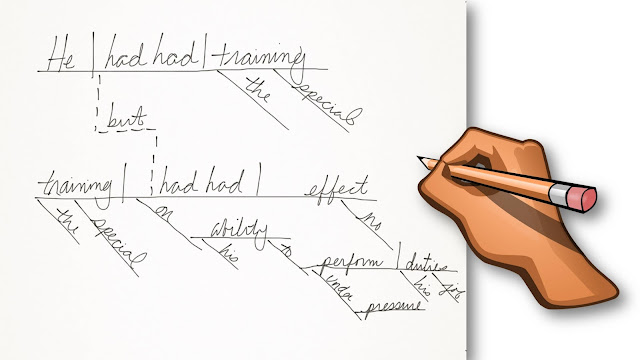To create the past perfect of a verb, English speakers add "had" to the past tense of a verb. The past tense of the verb "have" is "had." That means the past perfect tense of "have" is "had had."
Thinking about "had had" long and hard at 3 a.m. this morning, because that's the sort of thing what keeps English professors up at night, I came up with an example sentence that uses the past perfect of "have" twice in a row and once more for good measure. I then diagrammed that glorious sentence, added a few prepositional phrases to it, and diagrammed it again. Although this exercise might be the kind of thing to help most people fall asleep, it just excited me, and here I am writing about it four hours later.
Here's today's past perfect sentence diagramming challenge sentence:
He had had the special training, but the special training that he had had had had no effect on his ability to perform his job duties under pressure.
Step One: Separate the Clauses
Clause One (Independent): He had had the special training
Clause Two: (Independent): but the special training [that he had had] had had no effect on his ability to perform his job duties under pressure.
Clause Three: (Adjective Clause): that he had had
Step Two: Diagram the First Independent Clause
The subject of the first clause is "He," and the complete verb is "had had." "The" and "special" modify the direct object, "training."
Step Three: Diagram the Second Independent Clause
Connect the first and second clauses at their verbs using the coordinating conjunction, "but." The complete subject of the second clause is "the special training [that he had had]," the complete verb is "had had," and the object is "effect." "No," and the string of phrases, "on his ability to perform his job duties under pressure" are modifiers (with modifiers).
Step Four: Diagram the Adjective Clause
"That he had had" modifies "training" in the subject of the second clause. Therefore, as with all modifiers, it is diagrammed under the word it modifies. Because it is a clause connected to a clause, it is connected with a dashed line. Before it can be diagrammed, however, it must be rearranged. The subject should appear first. The rearranged clause, in standard subject-verb-object (SVO) order, reads "he had had that."
Do you have another challenging sentence that needs diagramming? Give it a try or present it in the comments below!
Want to read more about diagramming sentences? Try
Silly Sentence Saturday
Diagramming Pangloss: All Is for the Best in the Best of All Possible Worlds
Want to learn more about diagramming sentences?
Take my complete online course, "Sentence Diagramming: From Beginner to Expert in 12 Lessons" on Udemy, or purchase my text, Diagramming Sentences: A Playful Way to Analyze Everyday Language (affiliate link) on Amazon.
Copyright Amy Lynn Hess. Please contact the author for permission to republish.




.JPG)


No comments:
Post a Comment